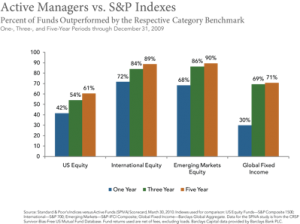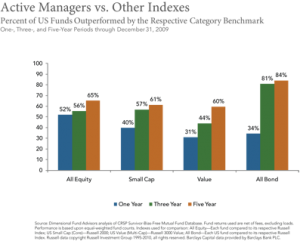Choosing a basic stock-bond mix is an important first step in portfolio design. Although the decision may appear simple, it can have a profound impact on your wealth.
Portfolio theory explains the value of making a deliberate, strategic decision about the proportion of stocks versus bonds to hold in a portfolio. This decision has roots in the “separation theorem,” which was proposed by Nobel laureate James Tobin in the late 1950s.1 The separation theorem proposes that all investors face two important decisions: (1) deciding how much risk to take, and then (2) forming a portfolio of “risky” assets (equities) and “less risky” assets (fixed income) to achieve this risk exposure.
Your stock-bond decision implements this risk position.
The Rationale
The theorem proposes that all investors who are willing to take stock risk should begin with a diversified market portfolio. Each investor then can dial down total risk in the portfolio by adding fixed income to the mix. The greater the bond allocation relative to stocks, the less risky the portfolio and the lower the total expected return; the greater the stock allocation relative to bonds, the higher the portfolio’s expected return and risk.
Investors who want to take even more risk than the market can increase exposure through borrowing on margin and/or tilting the stock portfolio toward asset groups that offer higher expected returns for higher risk.
So, how does one confidently allocate between stocks and bonds? A common method is to evaluate model portfolios along the risk-return spectrum. A riskier portfolio holds 100% stocks, and the least volatile portfolio holds 100% bonds. Between these extremes lie standard stock-bond allocations, such as 80%-20%, 60%-40%, 40%-60%, and 20%-80%.2 Then you compare the average annualized return and volatility (standard deviation) of each model portfolio for different periods, such as one, three, five, ten, and twenty years. Volatility is one of several risk measures investors may want to consider. With this in mind, the analysis should feature average returns, as well as best- and worst-case returns for the various periods.
While this technique relies on historical performance that may not repeat in the future, and does not consider various investment costs, it may help you think about the risk-return tradeoff and visualize the range of potential outcomes based on the aggressiveness of your strategy.
Refining Your Stock Allocation
After establishing the basic stock-bond mix, investors turn their attention to refining the stock allocation, which is where the best opportunities to refine the risk-return tradeoff are found. Investors who are comfortable with higher doses of equity risk can overweight or “tilt” their allocation toward riskier asset classes that have a history of offering average returns above the market. Research published by Eugene Fama and Kenneth French found that small cap stocks have had higher average returns than large cap stocks, and value stocks have had higher average returns than growth stocks. By holding a larger portion of small cap and value stocks in a portfolio, an investor increases the potential to earn higher returns for the additional risk taken.
The final step in refining the stock component is to diversify globally. By holding an array of equity asset classes across domestic and international markets, investors can reduce the impact of underperformance in a single market or region of the world. Although the markets may experience varying levels of return correlation, this diversification can further reduce volatility in a portfolio, which translates into higher compounded returns over time.
Fixed Income Strategies
Research shows that two risk factors—maturity and credit quality—account for most of the average return differences in diversified bond portfolios. Long-term bonds and lower-quality corporate bonds typically offer higher average yields to compensate investors for taking more risk. But keep in mind that these premiums are considerably lower than the market, size, and value premiums documented in the equity world.
Investors generally hold fixed income to either (1) reduce overall portfolio volatility, or (2) generate a reliable income stream. These objectives typically lead to different investment decisions. The first approach, volatility reduction, is an application of separation theorem (i.e., hold equities for higher return and use fixed income to temper portfolio volatility). Rather than increasing risk to maximize yield, these investors want to hold fixed income securities that are lower risk. Certain fixed income asset groups are better suited for this strategy.
With this in mind, some long-term investors may seek to earn higher expected returns by shifting risk to the equity side of their portfolio. With an eye to minimize maturity and credit risk, they hold short-term, high-quality debt instruments that have historically offered lower yields with much lower volatility.
The second purpose for holding bonds is to generate reliable cash flow. Income-oriented investors, including retirees, pension plans, and endowments, may not worry as much about short-term volatility in their bond portfolio. Their priority is to meet a specific funding obligation in the future. Consequently, they design a portfolio around bonds and accept more volatility in hope of earning higher yields, which they pursue by holding bonds with longer maturities and/or lower credit quality.
Whether investing for total long-term return or for income, a portfolio should be diversified across issues and global markets to avoid uncompensated risk from specific issuers and to capture differences in yield curves around the world.
Summary
The stock-bond decision drives a large part of your portfolio’s long-term performance. During portfolio design, evaluating different stock-bond combinations can help you visualize the risk-return tradeoff as you consider the range of potential outcomes over time. Once you determine a mix, it can guide more detailed choices of asset classes to hold in the portfolio. And as your appetite for risk shifts over time, you can revisit the mix to estimate how shifting your portfolio mix may impact your wealth accumulation goals in the future.
Endnotes
1 James Tobin, “Liquidity Preference as Behavior Towards Risk,” The Review of Economic Studies 25, no. 2 (February 1958): 65-86.
2 The basic stock component may be reflected by the S&P 500 Index, or preferably, by a broader market proxy, such as the CRSP 1-10 Index. The CRSP 1-10 Index is a market capitalization weighted index of all stocks listed on the NYSE, Amex, NASDAQ, and NYSE Arca exchanges. The S&P 500 Index offers a proxy of the large cap US equities market. The fixed income component may be represented by an index of short-term US government securities or government and corporate bonds.
The information presented above was prepared by Dimensional Fund Advisors, a non-affiliated third party.
Disclosures
Stock is the capital raised by a corporation through the issue of shares entitling holders to an ownership interest of the corporation. A bond is a loan that an investor makes to a corporation, government, federal agency, or other organization. Also known as debt or fixed income securities, most types of bonds pay interest based on a regular, predetermined coupon rate that is set when the bond is issued.
Although investors may form their expectations from the past, there is no assurance that future investment results will model historical performance.
Indexes are not available for direct investment. Their performance does not reflect the expenses associated with the management of an actual portfolio. Past performance is not a guarantee of future results.
Stocks offer a higher potential return as compensation for bearing higher risk. However, this premium is not a certainty and investors should not expect to consistently receive higher returns from stocks. In fact, market history shows extended periods when stocks did not outperform bonds.
Diversification neither assures a profit nor guarantees against loss in a declining market.
A bond portfolio designed for income also carries significant risks, including default and term risk, call risk, and purchasing power (inflation) risk. Foreign securities also are exposed to currency movements.

